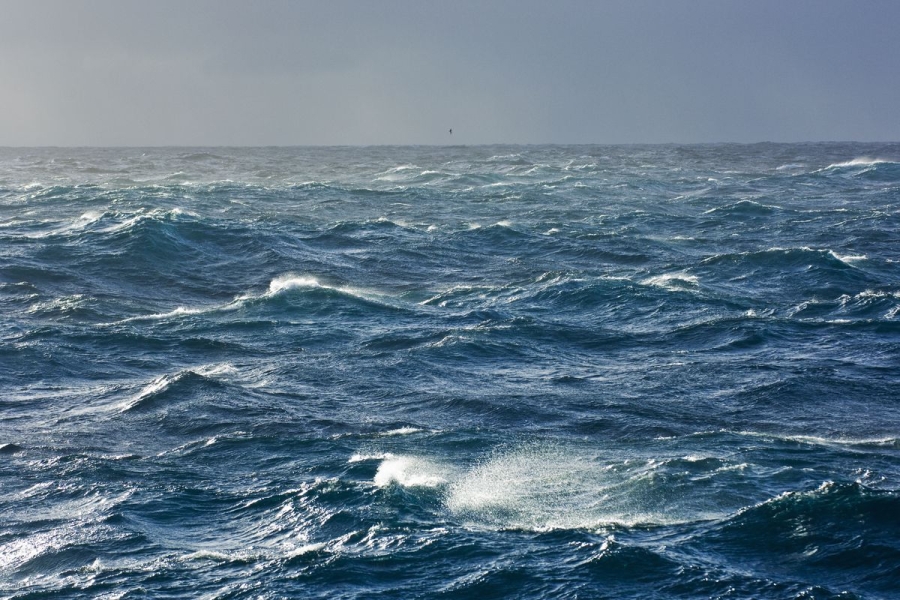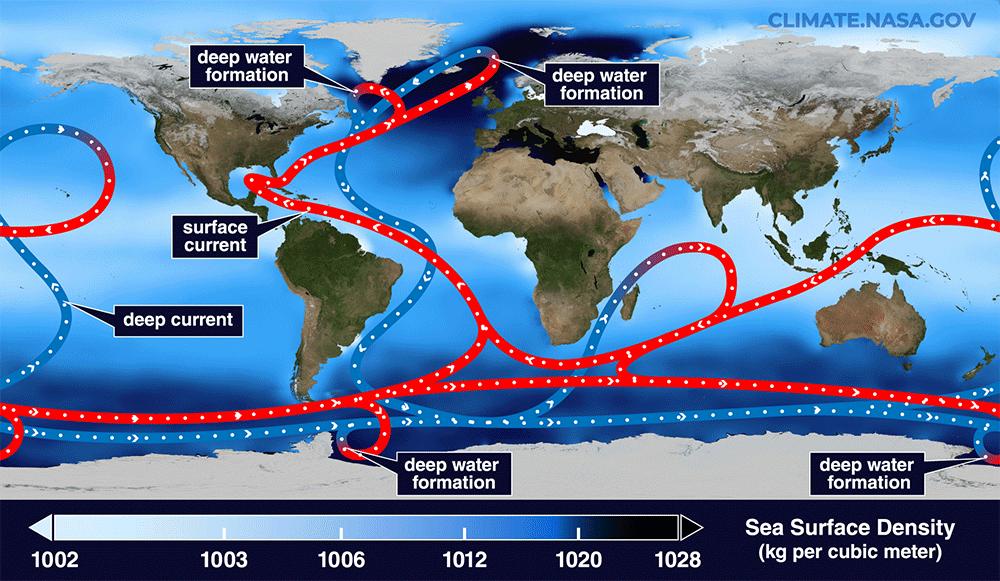The climate change scenario that could chill parts of the world, explained.

Brian Resnick is Vox’s science and health editor, and is the co-creator of Unexplainable, Vox’s podcast about unanswered questions in science. Previously, Brian was a reporter at Vox and at National Journal.
Of all the potential consequences of global warming, one of the most unexpected is that temperatures in some parts of the world could plummet.
A recent paper in Science Advances outlined a scenario where, given enough ice melting into the North Atlantic, average temperatures in cities like Bergen, Norway, could drop 15 degrees Celsius (a bone-chilling dip of 27 degrees in Fahrenheit). London could drop around 10°C (18°F).
But not only would temperatures in Europe plummet, the change would trigger a climate tipping point, generating cascading effects around the world. There would be more than two feet of extra sea level rise in North America. The Southern Hemisphere could grow warmer, potentially further destabilizing Antarctica’s ice sheets. In the Amazon rainforest, some parts would get rainier and others would dry out. Wildlife would suffer too, as essential nutrients for marine life would not as readily reach the Northern Atlantic.
And all of this would happen on top of the sea level rise that is already expected to disrupt so much of our world.
This scenario is high stakes, as it would vastly reshape the world as we know it. But it is also very uncertain, and hinges on a question scientists don’t know the answer to: Are humans going to break the Atlantic ocean?
“This is a sort of $2 million question,” Till Wagner, an atmospheric and ocean scientist at the University of Wisconsin-Madison, says. “Can this actually happen? And if so, when?”
The AMOC, explained
To understand how the Atlantic Ocean can break, we have to understand a feature found in no other body of water on Earth: a mechanism called the Atlantic Meridional Overturning Circulation (or just AMOC).
“Meridional” means a North-South orientation; “overturning” means there’s a vertical component, where water on the surface of the ocean sinks to the deep reaches; and “circulation” means the flow of liquid.
The AMOC is a three-dimensional ocean current — a sort of “conveyor belt” connecting water on the surface of the ocean to deep water below.
In the AMOC, warm water from the tropics moves northward on the surface along the coast of North America (this feature is more commonly known as the Gulf Stream). But when the water reaches the Northern latitudes, it grows colder. Colder water is denser than warm water. So from there, the cold water sinks closer to the ocean floor and heads southward, where the cycle starts again.


“This overturning is really important for climate,” says Nicholas Foukal, a scientist at the Woods Hole Oceanographic Institution. The AMOC is primarily a means for transferring heat. Heat from the tropics is transported over to Europe, which maintains milder temperatures despite the high Northern latitude of many of its countries. (The United Kingdom is roughly the same latitude as Newfoundland and Labrador in Canada, but the average January high temperature in London is 47°F, whereas in St. John’s, Canada, the average January high is closer to 32°F.)
“The concern is, as we’re melting ice sheets, it could introduce more fresh water to the Arctic,” Foukal says, producing a layer of fresh water on top of salt water.
Fresh water is less dense than salty water. Which is why ocean scientists suspect, over time, if you introduce enough fresh water into the Arctic, the water up there won’t be dense enough to sink and then move southward.
A strong enough slowdown in the AMOC could trigger its death spiral. “It’s a positive feedback loop,” Foukal says. “If you strengthen it in one direction, it will continue to strengthen.” If you pump the brakes on it hard enough, “it will turn off.”
Scientists are concerned about this happening in the future, because they think this death spiral has happened before.
Around 13,000 years ago, the Earth was emerging from its last ice age. Temperatures had been rising for thousands of years. Ice was melting. And then, suddenly, screech. For about 1,300 years, temperatures plummeted: The ice age was back on. The period is called the “younger dryas” — named for the cold-hearty dryas flowers that thrived during this period.
The best explanation for what happened during this time was that ice had been acting as a dam for an absolutely enormous lake that existed in modern-day Canada. When that dam burst, an estimated 21,000 cubic kilometers of fresh water (5038 cubic miles) diluted the salt content of the sea, triggering the system’s failure. For a comparison, today, Lake Superior contains around 3,000 cubic miles of water. All that fresh water, the theory goes, caused the AMOC to collapse.
Where is the point of no return?
Scientists will know when the AMOC is shutting down “when we see an acceleration in its decline,” says René van Westen, a climate scientist at Utrecht University in the Netherlands. The good news is that “we have measurements in place,” he says. “And at the moment they don’t show any evidence that it has tipped. It only shows evidence that it is weaker at the moment.”
Though when it does show that evidence of tipping, he says, “we’re already too late.”
Europe’s temperatures won’t plunge overnight. Once the accelerated decline starts, Van Westen says, we would only have about 100 years before the AMOC completely shuts down.
A big source of uncertainty is that scientists just don’t completely understand what drives the AMOC. They know it’s affected by temperature and salinity, but they don’t have a precise formula putting it all together. “We don’t have ‘plug in this temperature, this salinity into this equation, and you get an overturning of X cubic meters per second,’” Foukal says. “It just doesn’t exist.”
Scientists have only been measuring the AMOC directly since 2004. For such an important regulator of global climate and weather, there’s just not a ton of data on it.
And while there is convincing historical evidence that the AMOC collapsed during the younger dryas, it might not be a great analog to what’s happening today.
Back then, much of the Earth’s water was still locked up in ice. “Sea level was about a hundred meters below what it is right now,” Foukal says. The fresh water that burst and emptied into the ocean immediately went into the deepest parts. “That’s a very different system than what it is right now,” he says. The geography of the world was simply different, and maybe the AMOC shutdown played out differently then.
Despite those limitations, scientists do try to create computer models of the AMOC, and see what it takes to shut it down.
Recently Van Westen and co-authors published a modeling paper showing that you would need to dump a truly staggering amount of water into the Atlantic to cause the AMOC to collapse. “That is not very likely to happen in the near future,” Van Westen says, but adds that their model might be overstating the amount of water it could take to tip the AMOC. Overall, he says we’re “not certain how much additional melt water” is needed.
A separate recent modeling paper looked at trends in ocean temperature fluctuations in a particular area of the North Atlantic, and similarly concluded that an AMOC tip is possible starting between 2025 and 2095. Though they caution that “these results are under the assumption that the model is approximately correct.” (Modeling the entire ocean is very hard, and every model has limitations. “The trickiest part about modeling this is the whole system is very dependent on how the ocean and the atmosphere interact with each other,” Wagner says.)
I asked the scientists what to make of the conclusions of the two papers, which have generated some concerning headlines. Their take isn’t as apocalyptic as some of the headlines.
“There is an underlying potential for collapse — I think that exists,” Wagner says. “We have just simply not enough information to assess whether it is imminent or accessible in a realistic world. It might be that you would have to put our climate into such a strange state in order to shut the AMOC down.”
Of his own study, Van Westen says the strongest thing they can conclude is: “We have some indications that we are moving closer to the tipping point. But this doesn’t mean that we are crossing the tipping point. So I think that is a very important message. What we sketched over here is a potential future scenario.”
An uncomfortable uncertainty
The science here is uncomfortably uncertain. It’s not like a type of cancer, Wagner explains as an example, where you can track 10,000 patients and see 1,000 of them die. In that case you could conclude the probability of dying from that cancer is 10 percent. “In this case, we only have one AMOC.” There’s no way to calculate such certain odds of it collapsing.
So instead we have modeling papers, and scientists working on a mathematical understanding of this system. I’m told the uncertainties around the AMOC might be reduced with more direct observations of the system. But another problem is that we’re changing the climate so rapidly. If we understand how the AMOC works today, “it doesn’t mean we understand how it’s going to work in the future,” Foukal says. “And that’s because we’re perturbing our climate system so drastically.”
This system is complicated. As you warm the oceans, Van Westen says, the impact salinity has on water density can change. But not in a straightforward way — it’s possible, he says, the rising temperature of the ocean could, at times, counteract the impact of the fresh water.
“The lower latitudes are expected to increase in surface salinity due to higher temperatures and hence more evaporation,” Van Westen explains. “However, higher latitudes may freshen due to ice melt and receive more precipitation. Depending on the trends and ocean currents, you can have different salinity responses.” The ocean and how it’s changing is a hugely complicated system.
Those future potential ocean temperature changes weren’t factored into the current model — though Van Westen says he and colleagues are working on one that does.
There are some consequences of climate change that are certain. Temperatures will rise, and ice will melt. Sea level will rise. Weather patterns will shift. But some of climate change’s most impactful consequences are still deeply unclear. It’s scary: There’s a non-zero chance of this happening, and we might not know it is until it’s too late.
“We need to rule out such a potential future scenario,” Van Westen says. “And therefore, very urgent climate action is needed to limit our impact on Earth.”
Source: vox.com